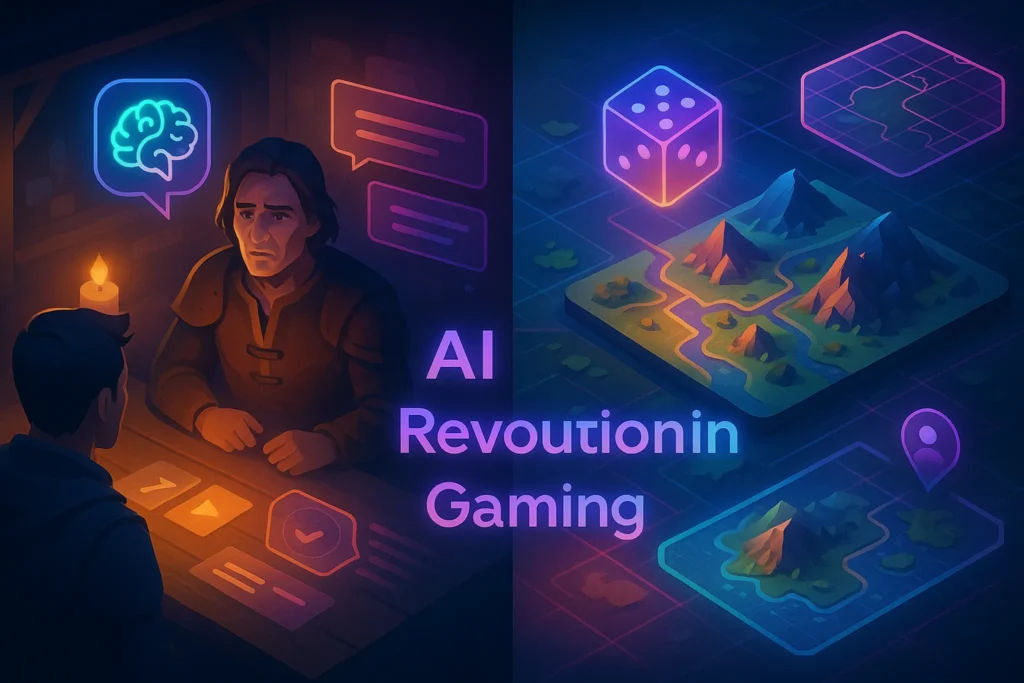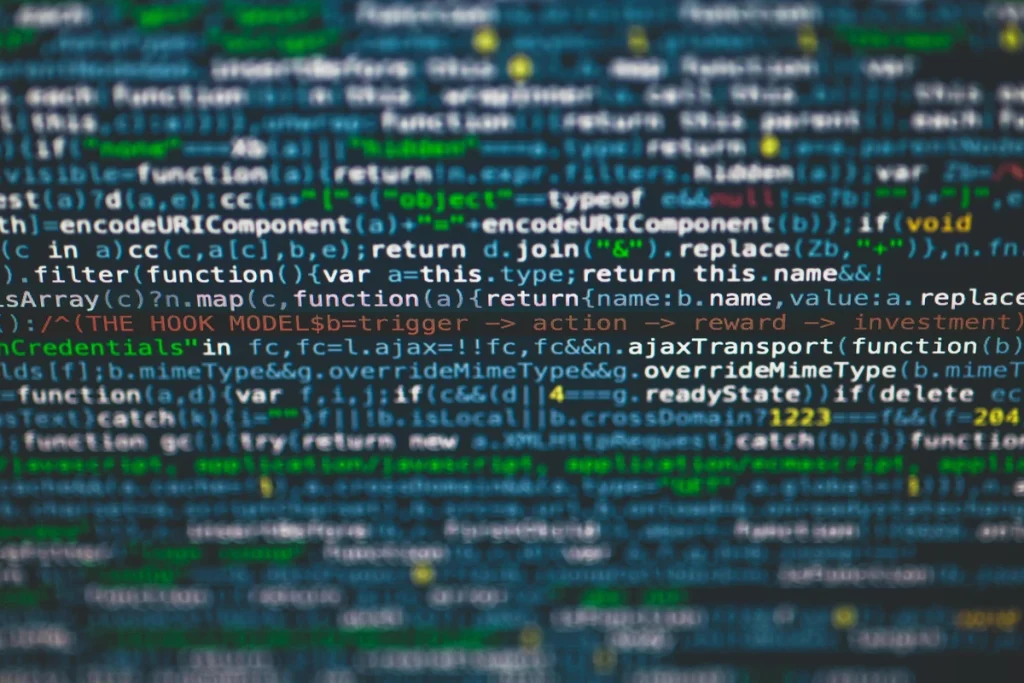-This post may contain affiliate links. If you click on one and make a purchase, I may earn a small commission at no extra cost to you.-
🎮 Introduction
Artificial intelligence isn’t just powering high-tech dramas or autonomous cars—it’s quietly redefining how games are created and played. In 2025, AI advancements are reshaping game development and gameplay in major ways:
-
👾 NPCs that learn, adapt, and react like humans
-
Dynamic game worlds that change based on player behavior
-
Personalized difficulty curves that meet you where you are
In this article, we explore key innovations in NPC behavior, dynamic balancing, procedural content, AI-powered asset creation, and the ethical challenges game studios face. Whether you’re a developer, pro gamer, or casual player, you’ll gain insight into where AI is taking gaming next.
1. 🤖 Smarter, Adaptive NPCs
Early game AI used simple scripts—“go here,” “attack now,” or “stand guard.” Today, NPCs are being powered by machine learning and generative AI, enabling dynamic reactions. Algorithms allow characters to observe player behavior and adjust tactics, simulating intelligence rather than pre-defined routines
One standout example: Nvidia ACE launched “PUBG Ally,” an AI teammate in PUBG that can navigate, fight, and support players in real time—acting more like a human ally than a predictable bot. Epic’s AI “Persona Device” allows creators to build NPCs in Fortnite with unique personalities that converse, react, and even misbehave—like the infamous AI Darth Vader.
Benefits:
-
Deepened immersion with organic interactions
-
Replayability as NPCs adapt to your style
Risks:
-
Unpredictable or inappropriate AI behavior
-
Concerns about replacing human voice and motion actors
2. 🎯 Dynamic Difficulty Adjustment (DDA)
Remember Left 4 Dead’s “AI Director,” which tweaked enemy spawns based on player performance? Today’s games use AI to dynamically tune difficulty in real time. Whether you breeze through levels or hit a wall, the game adjusts enemy behavior, puzzle complexity, or loot drops to maintain engagement.
Modern AI takes this further: real-time analytics track your playstyle, aiming success, and pace to offer tailored challenges. This keeps games feeling balanced and fair, catering to both newcomers and veterans .
3. 🌍 Procedural Content Generation (PCG)
Static worlds are on the way out. AI-driven procedural generation creates fresh environments, quests, and items every session . From No Man’s Sky’s infinite planets to AI-generated dungeons in Minecraft, PCG delivers endless surprises.
New tools let engines like Unity and Unreal generate dialogue, NPC backstories, and narratives using AI—injecting each playthrough with unique flavor.
4. 🎨 AI-Driven Asset and Audio Creation
AI isn’t just changing gameplay—it’s speeding up development. Studios use generative models like Stable Diffusion and Midjourney for concept art, 3D models, and environment design . On the audio front, tools such as Aiva and Amper create adaptive soundtracks dynamically fitting the player’s situation.
This reduces costs, boosts productivity, and empowers smaller teams to produce AAA-quality assets.
5. 🧠 Player Modeling & Personalization
AI now learns who you are and adapts accordingly. By analyzing playstyle, your emotional state, and challenge preferences, games can adjust pacing, narrative branches, and difficulty to match. Expect personalized experiences that evolve based on your unique journey.
6. ⚠️ Ethical & Practical Challenges
AI in gaming isn’t without pitfalls. Concerns include:
-
Unpredictability: AI actions can break immersion or narrative pacing.
-
Job displacement: Motion-capture actors and writers may be sidelined by AI systems .
-
Content ownership: Who owns an AI-generated map or character?
-
Ethical filtering: Games must ensure AI content summarizes human integrity and moderation
7. 🔮 What’s Next in AI Gaming
The horizon is full of promising developments:
-
Full NPC autonomy: In the future, characters may remember interactions, form relationships, and pursue goals—like a fully realized Skyrim with personalized NPC arcs .
-
Generative world-building: Provide a single concept or theme, and AI constructs rich game worlds complete with narrative threads.
-
Hyper-personalization: Games respond to your emotional state—slowing down in tense scenes when you’re stressed, or ramping up intensity when you’re in the zone.
-
Support for indie devs: Small teams can leverage open-source AI toolkits and engines like Unity ML-Agents to build smart gameplay with minimal resources.
🎮 Real-World Case Studies: How Games Are Already Using AI
Cyberpunk 2077 (Post‑Update)
After its rocky launch, CD Projekt Red overhauled Cyberpunk 2077 with patches that heavily integrated AI into NPC routines. Pedestrians no longer walk aimlessly; instead, they react to player aggression, run from gunfire, and even call for help—driven by pathfinding algorithms and behavior trees. This makes Night City feel alive, not just populated.
The upcoming expansion, “Phantom Liberty,” uses AI-driven crowd systems where groups react collectively. If one person panics, others follow—a major leap from isolated AI reactions.
The Sims 4 + Project Rene (Sims 5)
The Sims has always relied on AI for emergent gameplay, but Project Rene (the unofficial Sims 5 codename) goes deeper. EA has hinted that future Sims will feature adaptive emotional AI that lets your characters evolve over time based on social history, not just traits.
This creates unexpected narratives. Imagine a Sim who becomes reclusive after multiple failed romances—or one who starts sabotaging roommates due to jealousy, with no direct script.
Shadow of Mordor’s Nemesis System
One of the most famous AI systems in modern gaming, the Nemesis system let orc enemies remember encounters, grow stronger, and even taunt players uniquely based on past interactions. This introduced asymmetric storytelling where every player had a personal villain, generated dynamically.
It’s a classic use case of how procedural AI can fuel character-driven narratives.
🧠 AI in Competitive & Esports Games
While AI often shines in single-player games, its role in competitive gaming and esports is growing rapidly:
Anti‑Cheat Systems
AI is being deployed to detect subtle cheat patterns invisible to traditional detection software. By analyzing behavioral anomalies—like reaction times beyond human capability or perfect aim tracking—systems like FACEIT’s Anticheat AI and Valorant’s Vanguard can flag and ban cheaters in near real time.
This is especially critical in games like Valorant and CS:GO, where fairness defines the experience. (If you’re looking to improve legitimately, don’t miss our guide: How to Improve Aim in Valorant.)
Matchmaking Optimization
AI now drives skill-based matchmaking in games like Apex Legends, Fortnite, and Call of Duty. These systems go beyond win/loss ratios and consider heatmaps, movement efficiency, team synergy, and map control. The result? Fairer matches and longer player retention.
Esports Coaching
Top-tier teams use AI tools to analyze gameplay footage, predict enemy strategies, and optimize team rotations. Services like Mobalytics or Gosu.ai deliver data-driven coaching, breaking down performance into heatmaps, kill timings, ability usage, and more—valuable even for solo queue grinders.
🔧 Tools & Engines Using AI
Game developers increasingly rely on AI-integrated engines to speed up creation and enhance realism:
Unity ML‑Agents
Unity’s machine learning toolkit enables developers to train agents to navigate, strategize, and interact. It’s widely used in prototyping behaviors without manual scripting, especially for indie developers with tight resources.
For instance, AI agents can “learn” how to escape a maze, simulate team tactics, or balance survival conditions in an evolving ecosystem.
NVIDIA ACE for Games
Announced at CES, NVIDIA ACE enables game studios to build digital characters with real-time natural language dialogue, using speech-to-text, LLM processing, and facial animation generation. Their demo with PUBG Ally shows a voice-driven teammate who can assist, strategize, and even share banter—changing how AI companions are built.
Ubisoft Scalar
A next-gen cloud computing solution, Scalar enables Ubisoft games to stream entire AI-simulated environments that adapt on the fly. Rather than static NPCs, cities can evolve economically or socially based on player actions. It’s expected to debut in Ubisoft’s next MMO project.
🕹️ Player-Created AI Mods & Systems
Gamers aren’t waiting for studios—they’re building AI-enhanced content themselves.
-
Skyrim AI Overhauls like Immersive Citizens or Realistic AI Detection make townspeople smarter and more reactive.
-
In Minecraft, mods like AI Creatures give mobs pack behavior, emotional responses, and territory systems.
-
Modders even integrate ChatGPT into NPC dialogue trees in Mount & Blade II, Fallout 4, or GTA V, letting you converse with characters via natural language in real time.
This AI democratization blurs the line between dev and player—anyone can design smarter systems.
📈 The Business of AI in Gaming
Beyond creativity, AI is a serious business multiplier:
Cost Reduction
AI-generated assets reduce the need for massive animation teams or concept art departments. Studios like Ubisoft, CD Projekt, and indie devs alike report 30–50% faster production pipelines by using AI for prototyping, sound generation, or texture creation.
Market Advantage
Studios using AI effectively can pivot faster to market trends, prototype ideas quicker, and localize games faster (via AI translation and dubbing). This has become a key investment narrative in 2025, with major publishers funneling resources into AI labs.
Revenue Models
AI even impacts monetization—adaptive pricing, AI-curated item shops, and emotion-aware microtransactions are being explored. However, these raise ethical concerns around player manipulation, which we’ll monitor closely in future posts.
🧠 Nerd Thoughts
The AI revolution in gaming isn’t theoretical—it’s already underway. From reactive NPCs and procedural storytelling to AI-driven development pipelines and esports analysis, the medium is shifting. And as AI capabilities grow, players will no longer just play games—they’ll co-create them with living systems that respond, evolve, and remember.
❓ FAQ
Q: Can AI ruin game balance or lead to pay-to-win?
Yes—AI that tailors difficulty could bias loot or create hidden monetization loops. Transparency and player control are vital safeguards.
Q: Will human designers go extinct?
No—AI speeds up workflows, but developers remain essential—AI lacks nuance and creative judgment .
Q: Can player performance data be misused?
Data privacy must be protected. As AI gaming grows, players need clarity on data collection and usage .
💬 Would You Bite?
Do you want NPCs who remember your choices and worlds that change around you?
Jump into the comments and share your vision for smarter, AI-driven games! 👇



